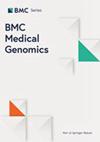转录组分析揭示了出血热合并肾综合征各恢复阶段的关键分子特征
IF 2.1
4区 医学
Q3 GENETICS & HEREDITY
引用次数: 0
摘要
出血热伴肾综合征(HFRS)是一种由汉坦病毒引起的危及生命的人畜共患疾病,具有极大的致死风险,且缺乏特效治疗方法。本研究旨在描述出血热伴肾综合征恢复阶段的转录组变化。研究人员采用 RNA 测序技术分析了 HFRS 患者外周血单核细胞在少尿期(OP)、利尿期(DP)和康复期(CP)的转录组变化。我们在更大的样本集中使用定量实时 PCR 验证了 12 个差异表达基因 (DEG)。我们的分析表明,DP 和 OP 之间存在明显的转录组差异,有 38 个 DEGs 在所有三个阶段都表现出一致的表达变化。值得注意的是,CD83 和 NR4A1 等免疫检查点基因的表达呈单调增长,而 IFI27 和 RNASE2 等抗病毒和免疫调节基因的表达则呈单调下降。此外,这项研究还阐明了免疫反应在三个阶段中的持续衰减,以及与组织修复和再生相关的通路的上调。我们的研究揭示了 HFRS 恢复阶段的转录组变化,阐明了可作为疾病进展和恢复生物标志物的关键基因和通路。本文章由计算机程序翻译,如有差异,请以英文原文为准。
Transcriptomic analysis reveals key molecular signatures across recovery phases of hemorrhagic fever with renal syndrome
Hemorrhagic fever with renal syndrome (HFRS), a life-threatening zoonosis caused by hantavirus, poses significant mortality risks and lacks specific treatments. This study aimed to delineate the transcriptomic alterations during the recovery phases of HFRS. RNA sequencing was employed to analyze the transcriptomic alterations in peripheral blood mononuclear cells from HFRS patients across the oliguric phase (OP), diuretic phase (DP), and convalescent phase (CP). Twelve differentially expressed genes (DEGs) were validated using quantitative real-time PCR in larger sample sets. Our analysis revealed pronounced transcriptomic differences between DP and OP, with 38 DEGs showing consistent expression changes across all three phases. Notably, immune checkpoint genes like CD83 and NR4A1 demonstrated a monotonic increase, in contrast to a monotonic decrease observed in antiviral and immunomodulatory genes, including IFI27 and RNASE2. Furthermore, this research elucidates a sustained attenuation of immune responses across three phases, alongside an upregulation of pathways related to tissue repair and regeneration. Our research reveals the transcriptomic shifts during the recovery phases of HFRS, illuminating key genes and pathways that may serve as biomarkers for disease progression and recovery.
求助全文
通过发布文献求助,成功后即可免费获取论文全文。
去求助
来源期刊

BMC Medical Genomics
医学-遗传学
CiteScore
3.90
自引率
0.00%
发文量
243
审稿时长
3.5 months
期刊介绍:
BMC Medical Genomics is an open access journal publishing original peer-reviewed research articles in all aspects of functional genomics, genome structure, genome-scale population genetics, epigenomics, proteomics, systems analysis, and pharmacogenomics in relation to human health and disease.
 求助内容:
求助内容: 应助结果提醒方式:
应助结果提醒方式:


